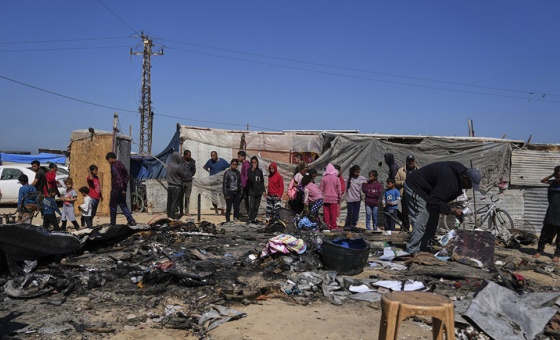This is the last article you can read this month
You can read more article this month
You can read more articles this month
Sorry your limit is up for this month
Reset on:
Please help support the Morning Star by subscribing here
ON MAY 6 Nato security-general Anders Fogh Rasmussen and Japanese Prime Minister Shinzo Abe met at the organisations headquarters to sign a new agreement on co-operation.
Both stated that Nato and Japan were “natural partners” and both drew paralells between the situations in Ukraine and the East and South China Seas.
Following the US lead, Rasmussen welcomed Abe’s offer that Japan’s military should play a greater role regionally and internationally and went on to declare that “the security and stability in the Euro-Atlantic and Asia-Pacific regions cannot be treated separately.” Both pledged to address global security challenges together in times of crisis.
Back in Tokyo, Abe redoubled his efforts for constitutional change to allow his country to wage war beyond its borders. Nato’s backing was surely influential in swaying the Japanese cabinet when, in July, it finally agreed to the historic reversal of the country’s peace commitment, sidestepping the constitutional requirement for a national referendum.
But then the majority of Japanese people don’t want to go to war. So much for Nato’s promotion of democracy.
The Japan link is part of a series of Nato partnerships with states in Asia and the Pacific. Nato members the US and Canada are of course themselves Pacific powers. But France and Britain also have Pacific interests, with France laying claim to New Caledonia and French Polynesia and Britain to the Pitcairn Islands.
Britain, which declares itself “at the forefront” in pursuing Nato’s global goals, also maintains a military base in Brunei at the southern edge of the South China Sea.
Nato has now, over the last two years, formed “partnerships across the globe” with Afghanistan, Iraq, Australia, Japan, Mongolia, New Zealand, Pakistan, the Philippines and South Korea.
Of these nine, five border China and two, Japan and the Philippines, are in dispute with China over islands in the East and South China Sea respectively.
In this way, Nato’s European members are becoming enmeshed into the US strategy of China containment
Under the guise of protecting “freedom of navigation,” the US insists on its rights to deploy a vast array of spy planes, destroyers equipped with Aegis radar systems and missile interceptors, nuclear submarines and aircraft carrier battle groups within miles of China’s mainland. As the latter seeks to push the US from its coastline, it finds itself accused of unbridled expansionism.
The US military build-up is destabilising the region, with longstanding and hitherto fairly dormant disputes in the East and South China Seas erupting into situations fraught with risk.
As warships, coastguard patrols and commercial fishing vessels from the disputants skirmish around the islands, mounting nationalism heightens the danger that an “accidental” collision may develop into a full-blown military confrontation with, in the cases of Japan and the Philippines at least, the US treaty bound to act “in defence.”
These disputes then set the stage for a dangerous rivalry between the two nuclear-armed superpowers. Declaring the South China Sea an area of its own national interest, the US seems set on a collision course with China. But Sino-Japanese relations are the real complicating factor, making the situation potentially more volatile than that between the US and USSR in the cold war.
Japan’s failure to confront its wartime past makes its remilitarisation deeply worrying to South Korea and China.
But with Japan bringing much-needed funds and supplies of sophisticated technical expertise, Nato has been prepared to turn a blind eye to Abe’s provocative visit in December 2013 to the Yasukuni shrine where WWII Grade-A war criminals are honoured. Japan’s extremist military-nationalists no doubt exulted. To view this all as great power rivalry returning to Asia is a mistake. The point is rather that the business of WWII in the east remains unfinished since China was frozen by the cold war out of the 1951 US San Francisco Peace Treaty.
Rising tensions are driving the region’s militarisation with total defence spending on the part of the south-east Asian states forecast to rise from $24.5 billion in 2011 to $40bn by 2016.
The US’s increasingly frequent naval visits, port calls and joint military training and exercises stoke up the all too flammable atmosphere. Nato members make this situation worse by selling arms and carrying out military exercises between Nato and Singapore in Canada and between Britain, the Brunei armed forces and the US military.
“Partnerships across the globe,” Nato asserts, do not necessarily mean involvement in direct action. Instead, they cover image-building co-operation in areas such as disaster relief and humanitarian assistance.
But they are clearly an endorsement of the US’s-Asian pivot and of Japan’s remilitarisation and implicitly subscribe to the view of China as the aggressor.
This can only help to complicate Pacific dynamics, risking the precipitation of conflict. The partnerships also cover collaboration in areas such as cyber and missile defence, intelligence sharing and surveillance, crisis management, conflict prevention and commitment to protect the freedom of navigation.
It is not inconceivable then that Nato’s European members may find themselves dragged into US battle plans by, for example, an “offshore control” operation involving the interdiction of shipping and aircraft or naval blockades at “choke points” to cut off China’s vital shipping routes. Or there could be a cyber attack to launch an all-or-nothing air-sea battle which, relying on surprise while “blinding” an adversary, is a sure recipe for rapid conflict escalation at risk of pushing disputes in the Asia-Pacific region to the brink of nuclear war.
The upcoming Nato summit in Cardiff will focus on military deployments on its eastern European flank, with the US pressing its European allies to share Nato’s military burden.
But, under the mantra “global concerns require multilateral solutions,” US strategy is to integrate Asian and European states together into a Washington-led world order.
Abe’s constitutional reinterpretation now brings the country into line with Nato aims of collective defence and Japan can actively join in Nato-led wars. It also brings the prospects of an Asian Nato closer. The Pentagon has long held the strategic goal of an east Asian security structure with its own collective defence arrangements to partner with Nato across the globe.
Nato and its Asian partners are coming together to form an integral part of the US high-tech “revolution in military affairs” and its global missile defence system to bolster the US global offensive capacity as it seeks to reverse its relative decline.
The object is the control of Eurasia, using the pincers of a global Nato, with both Atlantic and Pacific reach. The US proposals on trade — the Transatlantic Trade and Investment Partnership (TTIP) and the Transpacific Partnership (TPP) — are to provide a crucial economic undergirding, reviving the core position of the G7 to the exclusion of not only China but all of the Brics.
The US dream of a global Nato is not a foregone conclusion — its pivot has swung from Asia to eastern Europe to the Middle East. But as Hillary Clinton has declared, the future of world politics will be decided in Asia. Peace activists need to be alert to the dangers as the US strives to return its focus to that region, taking Nato with it.
You can follow Jenny Clegg on Twitter @JennyClegg1





